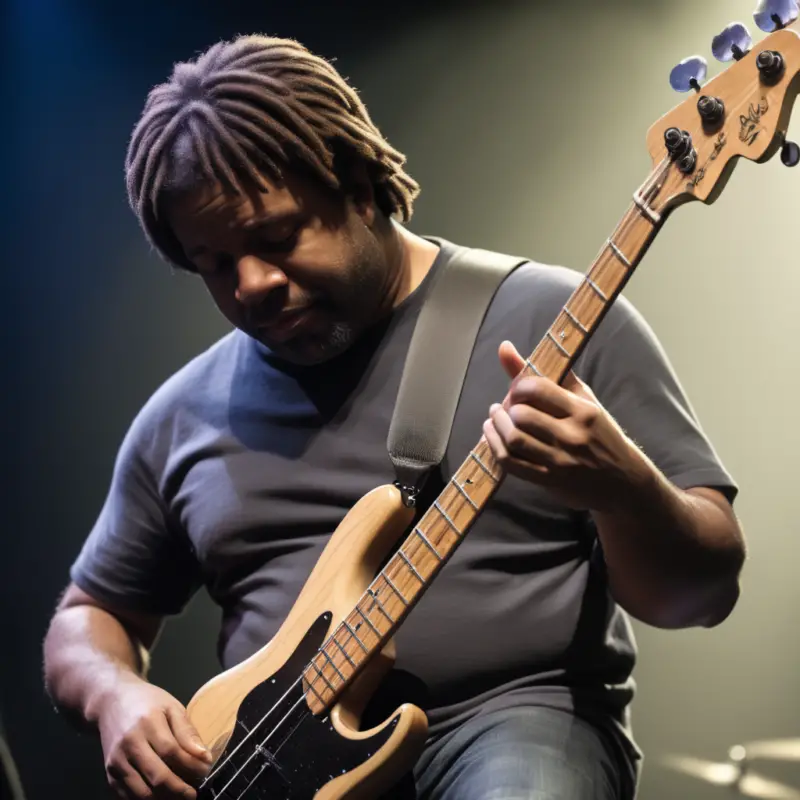Unlock the Secrets of Bass Guitar Plucking Technique: Mastering Finesse, Speed, and Groove
Are you ready to improve your bass guitar skills? Look no further! In this article, we explore the secrets of the bass guitar plucking technique and uncover the key elements that will help you master finesse, speed, and groove.
Whether you’re a beginner or an experienced bassist, understanding the fundamentals of the plucking technique is essential for achieving a clean and powerful sound. From finger placement to wrist motion, we’ll guide you through each step, providing expert tips and tricks.
Speed and agility are crucial for any bass player looking to stand out from the crowd. We’ll explore specific exercises and drills that will improve your speed and coordination, allowing you to navigate complex bass lines easily.
But it’s not just about speed; it’s also about groove. We’ll show you how to infuse your playing with that irresistible groove that makes people want to move. From syncopation to rhythmic variations, you’ll discover how to make your bass lines groove like never before.
So, whether you’re aiming to become a masterful session bassist or want to impress your bandmates, get ready to unlock the secrets of bass guitar plucking technique and elevate your playing to new heights.
Table of Contents
The Importance of Proper Technique
Proper technique is the foundation of any skilled bassist. It ensures you produce a clean and powerful sound, prevents injuries, and allows for efficient playing. There are several vital elements to consider when it comes to plucking techniques.
First and foremost, finger placement is crucial. Each finger should be positioned directly above the string it is plucking, allowing maximum control and accuracy. Additionally, the angle at which you attack the string can significantly affect the tone and articulation of your notes. Experiment with different angles to find what works best for you.
Another critical aspect of the plucking technique is wrist motion. A relaxed and fluid wrist allows for incredible speed and precision. Avoid excessive tension in your wrist and forearm, which can lead to fatigue and hinder your playing. To improve your technique, practice exercises that focus on wrist flexibility and control.
Lastly, don’t forget about the role of your thumb. The thumb should lightly rest on the pickup or the string below the one you’re plucking, providing stability and anchoring your hand. This ensures that your fingers have a solid foundation to pluck from, resulting in more controlled and consistent playing.
Different Plucking Techniques: Fingerstyle, Pick, and Slap
Bassists utilize various plucking techniques to achieve different sounds and styles. The most common techniques include fingerstyle, pick, and slap.
Fingerstyle is the most versatile and widely used technique among bassists. It involves using your fingers, typically the index and middle fingers, to pluck the strings. This technique allows for greater control, dynamics, and the ability to play complex patterns.
On the other hand, using a pick can produce a brighter and more aggressive sound. It is commonly used in genres like rock and metal, where a punchy and defined tone is desired. To master the pick technique, focus on maintaining a consistent attack angle and experiment with different pick thicknesses to find your preferred sound.
The slap technique, popularized by funk and slap bass players, involves striking the strings with the thumb and popping them with the other fingers. This technique creates a percussive and rhythmic sound, adding a unique flavor to bass lines. To develop the slap technique, practice exercises emphasizing thumb and finger coordination and muting techniques to control unwanted string noise.
Developing Finesse in Bass Guitar Plucking
Finesse is an essential aspect of bass guitar playing that separates good bassists from great ones. It involves controlling dynamics, executing subtle nuances, and creating a smooth and seamless sound.
One way to develop finesse in bass guitar plucking is to focus on your touch and control. Experiment with different levels of finger pressure when plucking the strings to achieve different dynamics. Practice playing softly and gradually increasing the volume, and vice versa; train your fingers to respond to different touch sensitivities.
Another aspect of finesse is note articulation. Please pay attention to how long you sustain each note and how you release it. Experiment with different durations and explore techniques like palm muting and ghost notes to add texture and depth to your playing. Developing finesse in note articulation will allow you to create more expressive and captivating bass lines.
Lastly, finesse involves being mindful of your overall technique and body posture. Ensure your movements are efficient and economical, minimizing unnecessary tension and wasted energy. Regularly assess and adjust your technique to optimize your playing and prevent bad habits from forming.

Mastering Speed in Bass Guitar Plucking
Speed and agility are crucial for any bass player looking to stand out from the crowd. While speed alone does not make a great bassist, it is an essential tool for fluidity and expressiveness in your playing.
To improve your speed in bass guitar plucking, start by focusing on your finger independence and coordination. Practice exercises that isolate each finger, such as playing scales or arpeggios with one finger per fret. This will help strengthen your fingers and improve their ability to move independently.
Additionally, incorporating exercises emphasizing alternate picking or finger rolling can significantly enhance your speed and agility. These exercises train your fingers to move quickly and smoothly across the strings, allowing you to navigate through fast-paced bass lines easily.
Furthermore, practicing with a metronome is essential for developing speed and maintaining accuracy. Start at a comfortable tempo and gradually increase the speed as you become more relaxed. Remember to keep a steady rhythm and clean technique, even at higher speeds.
Creating Groove and Rhythm with Bass Guitar Plucking
While speed is essential, it’s not just about how fast you can play; it’s also about how you can make people feel the groove. Groove is that infectious rhythmic feel that makes people want to move and dance. As a bassist, your role is to provide the foundation for the groove and drive the rhythm of the music.
It’s essential to develop a strong sense of timing and feel to create groove and rhythm with bass guitar plucking. Practice playing with a metronome or drum tracks to improve your understanding of timing and internalize different rhythmic patterns.
Syncopation is another crucial element in creating a groove. Experiment with playing notes slightly off the beat or accentuating specific beats to add a syncopated feel to your bass lines. This creates tension and anticipation, making the music more exciting and engaging.
Rhythmic variations are also effective in adding grooves to your playing. Instead of playing the same pattern repeatedly, try incorporating subtle variations in rhythm and note placement. This adds complexity and interest to your bass lines, keeping the listeners engaged and moving to the music.
Exercises and Drills to Improve Bass Guitar Plucking Technique
Now that we’ve covered the key elements of the bass guitar plucking technique let’s dive into some exercises and drills that will help you improve your skills.
1. Finger Independence Exercise: Place your fingers on the E string’s 1st, 2nd, 3rd, and 4th frets. Play each finger individually, starting with your index finger and moving sequentially to your pinky. Repeat this exercise on all strings, gradually increasing the speed.
2. Alternate Picking Exercise: Play a simple scale using alternate picking, starting with a downstroke and then an upstroke on each note. Focus on maintaining a consistent attack angle and keeping your picking hand relaxed and fluid.
3. Slap Technique Exercise: Practice the “pop and slap” technique by slapping the E string with your thumb and then popping the A string with your index or middle finger. Gradually increase the speed and experiment with different rhythmic patterns.
4. Groove and Rhythm Exercise: Play with a drum track or a metronome, focusing on locking in with the rhythm and accentuating specific beats to create a groove. Experiment with different rhythmic variations and syncopated patterns.
Remember to start slow and gradually increase the speed as you become more comfortable with each exercise. Consistent practice and repetition will help solidify your technique and improve your overall playing.
10 Best Slap Basses for Electrifying Basslines
Common Mistakes to Avoid in Bass Guitar Plucking
While it’s essential to focus on what to do to improve your bass guitar plucking technique, it’s equally important to be aware of common mistakes that can hinder your progress. By avoiding these mistakes, you can ensure you’re on the right track to becoming a skilled bassist.
One common mistake is excessive tension in the wrist and fingers. This can lead to fatigue, decreased speed, and a lack of control. Make a conscious effort to keep your wrist and fingers relaxed and fluid throughout your playing. Regular stretching exercises can also help alleviate tension and prevent injuries.
Another mistake is neglecting proper hand and body posture. Poor posture can result in discomfort, limited mobility, and inefficient playing. Ensure that your back is straight, your shoulders are relaxed, and your wrists are neutral. Regular stretching and strengthening exercises can help improve your posture and prevent long-term issues.
Another mistake to avoid is a lack of consistency in practice. Progress is achieved through regular and focused practice, so make it a habit to dedicate a specific time each day to working on your bass guitar plucking technique. Set goals for yourself, track your progress, stay motivated, and monitor your improvement.
Resources and Tools for Mastering Bass Guitar Plucking Technique
To further enhance your journey in mastering bass guitar plucking technique, here are some resources and tools that you can utilize:
1. Online tutorials and lessons: Numerous websites and platforms offer video tutorials and lessons specifically focused on bass guitar plucking technique. Take advantage of these resources to learn from experienced bassists and gain valuable insights.
2. Bass guitar instructional books: A wide variety of instructional books are available that cover various aspects of bass guitar playing, including plucking technique. Look for books written by renowned bassists or instructors to expand your knowledge and skills.
3. Bass guitar forums and communities: Joining online forums or communities dedicated to bass guitar playing can provide you with a supportive and knowledgeable network of fellow bassists. Share your experiences, ask questions, and learn from others on a similar journey.
4. Metronome and drum machine apps: Utilize metronome and drum machine apps on your smartphone or computer to practice rhythm and timing. These tools can help you develop a solid sense of timing and improve your ability to groove with the music.
Remember to approach these resources and tools with an open mind and a willingness to learn. Take advantage of the available information and tailor your learning experience to suit your needs and goals.
Conclusion and Final Thoughts
Congratulations! You’ve now unlocked the secrets of bass guitar plucking technique and are well on your way to mastering finesse, speed, and groove. By understanding the importance of proper technique, exploring different plucking techniques, and practicing exercises and drills, you can elevate your bass playing to new heights.
Remember that mastering the bass guitar plucking technique is a journey that requires time, patience, and consistent practice. Embrace the process, stay motivated, and always strive for improvement. With dedication and a passion for the instrument, you’ll continue to grow as a bassist and find your unique voice in the world of bass guitar playing. So, get your fingers ready, and let the music groove!


